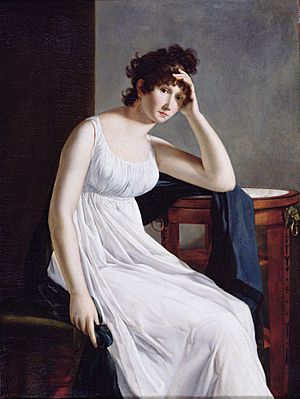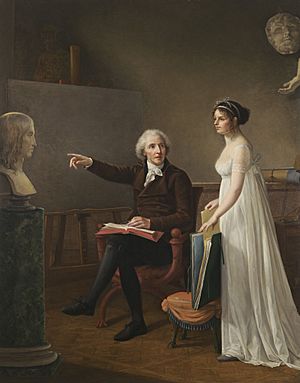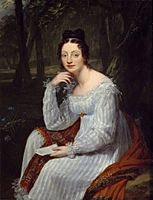Constance Mayer facts for kids
Quick facts for kids
Constance Mayer
|
|
|---|---|

Self-Portrait. Oil on canvas. Bibliothèque Marmottan
|
|
| Born |
Marie-Françoise Constance Mayer La Martinière
9 March 1775 |
| Died | 26 May 1821 (aged 46) |
| Nationality | French |
| Occupation | Painter |
| Movement | Neoclassicism |
Marie-Françoise Constance Mayer La Martinière (born March 9, 1775 – died May 26, 1821) was a French painter. She was known for her beautiful portraits, allegorical paintings (which tell a story or represent an idea), miniatures (tiny paintings), and genre works (scenes from everyday life). Constance Mayer had a very successful but also challenging career as an artist.
Contents
About Constance Mayer
Constance Mayer was born in France in 1775. Her father was a successful government official. From a young age, Constance showed a talent for art.
Her Early Art Studies
In her early twenties, Constance painted scenes from everyday life and portraits. She studied with famous artists like Joseph-Benoît Suvée and Jean-Baptiste Greuze. From them, she learned to use soft brush strokes. She created paintings that showed gentle and emotional scenes. For example, Greuze was known for painting subjects that looked innocent or vulnerable.
After the French Revolution's Reign of Terror (a very violent period), society became calmer. During this time, small portrait paintings and miniatures became very popular. Constance painted many portraits of women and children. She also created family scenes and self-portraits. She even painted miniatures of her own father.
Becoming a Recognized Artist
Constance Mayer became quite successful. She showed her art in important exhibitions called "salons." At one salon in 1801, she displayed a painting called Self-Portrait with Artist's Father. In this painting, her father points to a statue of the famous painter Raphael. He seems to be encouraging her to follow Raphael's example.
Constance was aware that it could be harder for women artists to be accepted. So, she sometimes presented her work as if she were a student of Greuze and Suvee. This helped her paintings be more easily accepted by the public. Around 1801, she also worked in the studio of Jacques-Louis David, another very famous artist. Under his guidance, her style became more direct and simple, but she still painted emotional scenes.
Working with Pierre-Paul Prud'hon
In 1802, Constance began studying with Pierre-Paul Prud'hon. Their relationship was not like a typical teacher and student. They were more like equals. Both had already shown their art in salons. Constance had a better art education than Prud'hon. He was especially known for his amazing drawing skills.
Around 1803, the French Emperor Napoleon bought two of Constance's paintings. He gave her an apartment in the Sorbonne, a famous university building. At the same time, Napoleon also gave Prud'hon an apartment there. Prud'hon had separated from his wife and was raising his five children. Constance became Prud'hon's assistant. She helped raise his children and was known as his "favorite student."
After 1804, Prud'hon greatly influenced Constance's artwork. Her paintings started to receive even more praise. This partnership continued for many years.
A Tragic End
In 1821, Constance learned that Prud'hon would have to leave the Sorbonne. Around this time, Prud'hon's wife passed away. Constance had hoped that she and Prud'hon would marry. However, Prud'hon did not propose to her. Constance faced many challenges and became very distressed. Sadly, her life ended tragically in 1821.
The year after her death, Prud'hon organized a special exhibition of her artworks. He himself passed away in 1823. Constance Mayer and Pierre-Paul Prud'hon are buried together in the Père Lachaise cemetery in Paris.
Her Artistic Legacy
Constance Mayer was one of several successful women artists after the French Revolution. Other notable women artists of that time included Pauline Auzou, Marguerite Gérard, Antoinette Haudebourt-Lescot, and Marie-Denise Villers. Even though women artists faced challenges in their profession, many still made great progress.
Constance Mayer's work has been shown in important exhibitions. For example, the National Museum of Women in the Arts featured her art in a collection from the State Hermitage Museum.
Gallery
See also
 In Spanish: Constance Mayer para niños
In Spanish: Constance Mayer para niños




